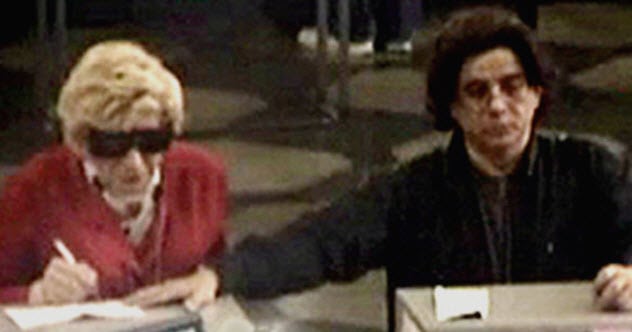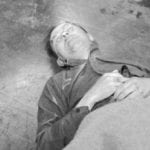 Humans
Humans  Humans
Humans  Animals
Animals 10 Animals That Humiliated and Harmed Historical Leaders
 History
History 10 Most Influential Protests in Modern History
 Creepy
Creepy 10 More Representations of Death from Myth, Legend, and Folktale
 Technology
Technology 10 Scientific Breakthroughs of 2025 That’ll Change Everything
 Our World
Our World 10 Ways Icelandic Culture Makes Other Countries Look Boring
 Misconceptions
Misconceptions 10 Common Misconceptions About the Victorian Era
 Mysteries
Mysteries 10 Strange Unexplained Mysteries of 2025
 Miscellaneous
Miscellaneous 10 of History’s Most Bell-Ringing Finishing Moves
 History
History 10 Great Escapes That Ended Right Back in Captivity
 Humans
Humans 10 Everyday Human Behaviors That Are Actually Survival Instincts
 Animals
Animals 10 Animals That Humiliated and Harmed Historical Leaders
 History
History 10 Most Influential Protests in Modern History
Who's Behind Listverse?

Jamie Frater
Head Editor
Jamie founded Listverse due to an insatiable desire to share fascinating, obscure, and bizarre facts. He has been a guest speaker on numerous national radio and television stations and is a five time published author.
More About Us Creepy
Creepy 10 More Representations of Death from Myth, Legend, and Folktale
 Technology
Technology 10 Scientific Breakthroughs of 2025 That’ll Change Everything
 Our World
Our World 10 Ways Icelandic Culture Makes Other Countries Look Boring
 Misconceptions
Misconceptions 10 Common Misconceptions About the Victorian Era
 Mysteries
Mysteries 10 Strange Unexplained Mysteries of 2025
 Miscellaneous
Miscellaneous 10 of History’s Most Bell-Ringing Finishing Moves
 History
History 10 Great Escapes That Ended Right Back in Captivity
10 People Who Sued Themselves
It is rare to hear of someone suing himself. So rare that no one has even bothered to form a word for it yet. Perhaps we could just call it “self-litigation.”
The obvious problem with self-litigation is that the plaintiff is also the defendant and, depending on the circumstances, the only witness. Then there’s the issue of representation. Do you hire one lawyer or two? Can you represent yourself, or is that a conflict of interest?
Despite its rarity and the possible complications, tales of self-litigation have been reported since at least 1899.
10 Curtis Gokey

In 2006, Curtis Gokey slammed Lodi, California, with a $3,600 lawsuit after a dump truck owned by the city crashed into his car. The lawsuit would not have raised eyebrows except that Gokey was the one driving the dump truck. It meant he was practically suing himself for an accident he caused.
The city turned down Gokey’s claim because he obviously couldn’t sue himself. The case did not end there, though. Gokey’s wife, Rhonda, took it up and sued the city and, by extension, her husband, for $4,800—$1,200 more than what her husband had asked for. Lodi city attorney Steve Schwabauer stated that this was also impossible.[1]
Under California law, a husband and wife were considered as one. While the wife could sue for certain things like divorce, she could not sue for negligence, which was what happened in this instance. Rhonda claimed that she had every right to sue the city because their dump truck damaged her vehicle. In her view, whoever was driving it was irrelevant.
The city prevailed.
9 Oreste Lodi

In 1985, Oreste Lodi dragged himself to a California court over an estate he owned. According to Lodi, he had tried to retrieve from himself an estate that he owned and gave to himself to manage, but he refused to release it to himself. The court dismissed the case, but the determined Lodi appealed the decision.
He filed two briefs for the appeal, one supporting himself for wanting to retrieve his estate from himself and the other against himself for not releasing his estate to himself. Again, the court dismissed the appeal because the plaintiff and defendant needed to be different people. In this instance, Lodi would have been the winner and loser no matter what decision was reached by the court.
The court categorized the appeal as frivolous and initially considered whether Lodi needed to pay for filing a frivolous appeal. It later decided that each Lodi—the plaintiff and defendant—had to pay for the appeal. This means Lodi paid twice.[2]
It remains unclear why Lodi sued himself, but it is suspected to have something to do with taxes. At the time he pressed charges against himself, he sent a copy of the litigation to the Internal Revenue Service.
8 Lothar Malskat

In 1952, an artist called Lothar Malskat sued himself for art forgery. The backstory could be traced to 1942 when Britain bombed Lubeck, Germany. The bombing destroyed almost every building in the city, including the Marienkirche (St. Mary’s Church) that was built in the 1200s. The church sustained serious damage but its walls remained standing. The bombing revealed previously unseen Gothic frescoes that were hidden underneath its walls during construction.
After the war, the German government and the church commissioned Dietrich Fey, a famous art restorer, and Lothar Malskat, his assistant, to fix the frescoes. What Fey and Malskat never mentioned was that the frescoes had seriously deteriorated. They turned to dust on touch. However, the duo went to work and revealed what was initially thought to be the restored church paintings in 1951.
Everyone was impressed, and Fey and Malskat went on to do several other restorations. But Malskat was not content. Fey got all the credit for the restorations while Malskat got nothing. Fey also got the bulk of the money while Malskat received only a small portion, sometimes just one-fifth. This made Malskat reveal the fraud and, at the same time, sue himself for fraud.[3]
No one believed Malskat until he pointed out that Mary Magdalene was not wearing shoes in the new painting even though she wore shoes in the original. The faces of the king and monks had also been replaced by those of random people, and a painting of an Austrian actress was added to the background. The frescoes also included some turkeys even though there were no turkeys in Germany in the 13th century.
The church removed the frescoes, leaving a small portion as a reminder of the forgery. Malskat received 18 months imprisonment for his involvement. He never got the fame he always wanted and remained a struggling artist until his death.
7 Robert Lee Brock

In 1995, Robert Lee Brock, who was serving time at the Indian Creek Correctional Center in Chesapeake, Virginia, sued himself for $5 million. However, he demanded that the state pay the damages because he had no money to give himself.
According to the lawsuit, Brock had drunk alcohol on July 1, 1993, which was against his religious beliefs. Besides, it made him commit a crime for which he was arrested. At the time that the lawsuit was filed, Brock was serving a 23-year sentence for burglary and grand larceny.
Judge Rebecca Beach Smith dismissed the case. While she agreed that Brock had been innovative in his approach to getting justice, it was ridiculous.[4]
6 Larry Rutman

On August 5, 1996, the South China Morning Post reported that Larry Rutman of Owensboro, Kentucky, had sued himself for $300,000 and won. However, he will not pay himself a dime. The bills will be picked by his insurance company.
According to the news, Rutman was throwing his boomerang when it hit his head. The accident supposedly altered his memory and increased his sex drive.
Initially, Rutman wanted to sue the boomerang maker for the accident, but his lawyer told him to sue himself instead. He did and won. According to the judgment, Rutman was to pay himself $300,000 for causing “body damage through negligence and carelessness” to himself.[5] As interesting as this incident sounds, there are claims that it never happened.
5 David Jennings

On January 8, 1899, The New York Times reported the story of David Jennings from Fort Scott, Kansas, who had sued himself and won. Jennings was the treasurer of Labette County, Kansas.
He sued himself after refusing to accept a tax payment he had made to himself. The tax was for a property that he used for his business. The court sided with Jennings and ordered that he should not force himself to pay any tax to himself.[6]
4 John Fred Heiniger

On June 26, 1912, the Los Angeles Herald reported the story of John Fred Heiniger who had won a lawsuit he filed against himself to quiet title. “Quiet title” is legal terminology that refers to establishing a person’s title to a property while “quieting” any other claims or challenges to that ownership from others.
The newspaper did not provide any backstory about the case except that Heiniger had prevailed in court. Technically, this also meant that he lost the lawsuit.
Besides being the plaintiff and defendant in the case, Heiniger was also the only witness and the process server (the person who delivers or “serves” court papers to the defendant or others in a legal action).[7]
3 Thomas Prusik-Parkin

In 2003, Thomas Prusik-Parkin sued himself while trying to fraudulently recover a house that he had lost after defaulting on a mortgage. The whole thing started in 1996 when his mother, Irene, transferred a house to him. Thomas took out a $200,000 mortgage on the property to start a business. The venture failed, and Thomas defaulted on his mortgage. The house was sold to Samir Chopra in 2003.
Coincidentally, Irene died the same year. However, Thomas gave the funeral director a fake social security number to keep Irene’s death hidden from the government. At the same time, he took the $700 she received from Social Security every month.
But Thomas did not stop there. He was not ready to lose the house, so he claimed that the deed transfer from Irene to him in 1996 had been forged—by him. Therefore, he argued that he couldn’t have legally taken out a mortgage on the house.
However, Thomas did not make the claim as Thomas but as Irene. To keep up the ruse, he sued himself for the forgery. To an outsider, it was Irene suing her son. But to Thomas, he was suing himself. At the same time, Chopra and (the real) Thomas dragged themselves to court, with each one accusing the other of fraud. Investigators became suspicious and did some digging. They discovered that Irene was dead.
To confirm their suspicions, they set up a meeting between Irene and Chopra. Interestingly, Irene attended the meeting. She was dressed in lady’s clothes, complete with painted nails and lipstick. She also had an oxygen tank.
However, investigators were not fooled. They were sure that Irene was dead and even had a picture of her tombstone as evidence. Apparently, Thomas was the one dressed in Irene’s clothing. The moment the scam was revealed, Thomas mentioned that he was his mother because his mother had died in his arms.
This was not the first time that Thomas had dressed up as Irene. Earlier, he had worn her clothes, wig, and sunglasses on a trip to the Department of Motor Vehicles to renew her license. He was handed a 13-year sentence on May 3, 2012. Mhilton Rimolo, Thomas’s accomplice who often followed the fake “Irene” to banks and pretended to be “her” nephew, received a three-year sentence.[8]
2 Emert Wyss

In 2005, Illinois attorney Emert Wyss mistakenly sued himself. Three years earlier, his client Carmelita McLaughlin had purchased a house, which she later refinanced. However, the mortgage company handling repayment passed responsibility to another mortgage company, Alliance Mortgage.
Wyss saw an opportunity and advised McLaughin to sue Alliance Mortgage for what he called “illegal fees.” It was agreed that Wyss would receive 10 percent of the settlement paid to McLaughlin if the case was successful. Wyss only realized he was suing himself after Alliance Mortgage revealed that Centerre Title Company—which charged the fees that Wyss called “illegal”–was owned by Wyss.
The court determined that Wyss and the Centerre Title Company had to be parties to the lawsuit in order for the case to proceed. As a result, Wyss could no longer act as counsel for McLaughlin, so he quietly moved to the other side to become the defendant in a lawsuit he started. The judge later dismissed Wyss as defendant because he and the Centerre Title Company could be treated as different entities.
A move to sanction Wyss was abandoned after he agreed not to charge the Centerre Title Company any attorney fees. It didn’t matter anyway as he would have been the one paying himself.[9]
1 Barbara Bagley

In 2015, 55-year-old Barbara Bagley sued herself over an accident she caused in December 2011. On the fateful day, she was driving in the Nevada desert when she crashed the vehicle. The impact threw her passenger and husband, Bradley Vom Baur, into a bush and seriously injured him. He died 10 days later.
Barbara demanded that the insurance company compensate her for the medical and funeral bills of her late husband. The insurance company refused. They argued that Barbara was not eligible for any compensation because she caused the accident. However, they were ready to pay for the car. A Utah appeals court ruled that Barbara could sue herself to receive compensation from the insurance company.
So Barbara (the widow and heir of the late Vom Baur) sued Barbara (the driver) for negligence. The complication of such legal action is that Barbara will need to provide evidence against herself to prove that she was negligent while driving.
She hired a lawyer to represent Barbara (the widow). Barbara (the driver) is represented by the insurance company’s attorneys because they would have to pay the judgment if Barbara (the driver) loses the case.
But that’s not all. Barbara is also the personal representative of her husband’s estate. That Barbara is also suing Barbara (the driver). So Barbara is two plaintiffs and one defendant in the same lawsuit.[10]
As far as we know, the case has not been decided yet. But there is a bit of good news. The couple’s dog was in the car at the time of the accident. The dog ran away but was found almost two months later in good condition. No word on whether the dog is suing anyone.
Read about more bizarre lawsuits on 10 Of The World’s Most Ridiculous Lawsuits and 10 Criminals Who Sued Their Victims.








